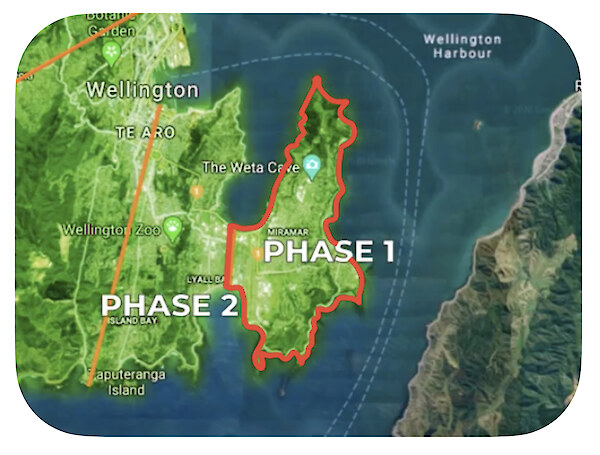 Miramar Peninsula (Phase 1)Making Miramar Peninsula predator free was the first stage of our wider plan to make Wellington the world’s first predator free capital city!
Miramar Peninsula (Phase 1)Making Miramar Peninsula predator free was the first stage of our wider plan to make Wellington the world’s first predator free capital city!
We need your help to keep Mirarmar predator free – please report any signs of rats
Why start in Miramar? Te Motu Kairangi was a perfect starting place as it has a bit of everything! 1086 ha of urban, suburban, bush and steep coastal escarpment, 12 schools, 19,230 residents across seven socioeconomically and culturally diverse suburbs. Importantly, the Wellington Airport runway across Rongotai gave us a natural barrier which was easier to defend. As an added bonus, the Peninsula has been possum free since 2006.
Where are we at? Predator free! We removed Norway rats and weasels in 2021, and completed Phase 1 in November 2023 by removing ship rats. You can read more about this exciting milestone or catch up on the celebration event.
We actively monitor the Peninsula in case rats try to sneak back in. We’re also working in our Phase 2 area.
How do we protect the gains? We expect rats may occasionally reinvade the Peninsula but we are confident we can find and remove them. We use a rat detector dog team, monitoring cameras, volunteers and local residents – and the system works! As we work through our Phase 2 project this will take the pressure off the Peninsula. If you live on the motu and detect any sign of rats, please let us know! We rely on Miramar locals to be our eyes and ears on the ground to prevent pests sneaking back in.
The outcomes for our native taonga are amazing. There has been a 91% increase in signs of native birds, which includes, including five times more pīwakawaka and 250% more riroriro. We’ve also recorded a 200% increase in tree wētā. Anecdotally, we’re spotting species previously absent from the Peninsula such as kārearea (rarer than kiwi), kākāriki, kākā, ruru and geckos.
 This has all been made possible by backyard trapping group Predator Free Miramar (PFM). Dan Henry kickstarted the group in 2017, and five years later this hugely motivated community of over 1,000 households has caught more than 10,000 introduced predators! We also had committed locals that met every Sunday while Phase 1 was active to clear traps along the coast and reserves – making up 10% of our operational workforce on the Peninsula. They also help our biosecurity monitoring process. You can learn more about the PFM story by reading Dan’s profile and his handy guide ‘How to kill rats and engage a community’.
This has all been made possible by backyard trapping group Predator Free Miramar (PFM). Dan Henry kickstarted the group in 2017, and five years later this hugely motivated community of over 1,000 households has caught more than 10,000 introduced predators! We also had committed locals that met every Sunday while Phase 1 was active to clear traps along the coast and reserves – making up 10% of our operational workforce on the Peninsula. They also help our biosecurity monitoring process. You can learn more about the PFM story by reading Dan’s profile and his handy guide ‘How to kill rats and engage a community’.
Want to report a sighting or have an enquiry? Contact us. Want to find out more about our project? Have a read of our FAQs.
